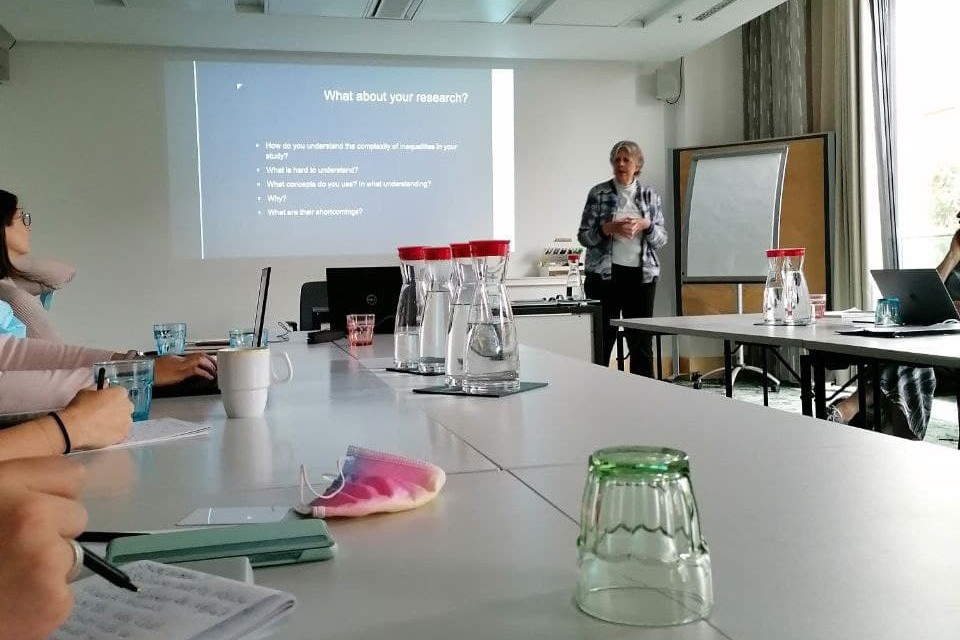Keynote lecture by Professor Mieke Verloo, Radboud University Nijmegen during the G-Versity Summer School in Berlin
Diversity and intersectionality are two key concepts in the research areas that G-Versity fellows tackle. Professor Mieke Verloo’s engaging keynote – which turned out to be a compelling workshop rather than a talk – invited us as early-stage researchers, to think critically about the different understandings that academic research offers about diversity and intersectionality.
Our starting point is Kimberlé Crenshaw’s concept of intersectionality, which emphasizes inequality in a structural sense. Although Crenshaw’s concept is rooted in black feminism in the context of the United States and she calls particular attention to the intersection of racism and sexism, intersectionality is not limited to race and gender. Class, sexual orientation, age, ability, and other aspects of identity are all mutually constitutive in the way we experience the world around us.
Professor Verloo offers two views on the application of intersectionality in research. On the one hand, structural intersectionality focuses on inequalities and their intersections, which are relevant at the level of people’s experiences in society. In this context, we might focus on questions about how different intersectional identities interact and influence each other. For example, gender and race can interact in a way that creates additional inequalities: in domestic violence shelters, it is possible that women who cannot speak the local language do not have access to adequate assistance. On the other hand, political intersectionality places inequalities and its intersections at the core of political strategies. From this point of view, we might be interested in questions about how certain gender diversity policies marginalize different groups, such as ethnic minorities or the LGBTQ+ community.
To illustrate the importance of a deep understanding of diversity and intersectionality in research, Professor Verloo offers an intriguing example by highlighting sections of the German Diversity Charter. The Charter contains six statements that are organizational commitments to diversity. Organizations pledge to statements such as “We maintain an organizational culture that is characterized by mutual respect and appreciation. We create the prerequisites for managers and employees alike to recognize, share and live these values.” or “Review our HR processes and ensure that they meet the diverse skills and talents of all employees, as well as our performance standards.”
However, diversity in this document is accompanied by words such as skills, talents, and notions that imply that diversity should be used advantageously for businesses and organizations in order to gain economic benefits. In this regard, diversity is not understood from what we have previously seen in Crenshaw’s conceptualization.
Through a discussion with the participants in the event, we agree that important words are missing in the statements of the Charter. Academic and critical endeavors about diversity usually deal with discrimination and prejudice, power relations, inequality, and exploitation. The solutions tend to focus on solidarity, training, coalitions and mentoring. Diversity in organizations is important not only because of economic gains but also because of the pursuit of equality. Institutions can overcome and challenge inequalities by looking at the status quo and power dynamics, both within their organizations and in a broader sense within society.
In my own research, investigating how adolescents perform and negotiate their gender and sexuality on social media, I intend to keep intersectionality at the core of my inquiry. Looking at both gender and sexuality already offers an intersectional approach, but other facets of identity may also be crucial in my analysis. Class, ethnicity, and religious background can be important attributes of a person’s gender and sexual identity. Since my fieldwork will be carried out in Hungary, I am interested in learning about the different local understandings of intersectionality, including gender and race, as well as the historical and political context that shapes this understanding.
During these first months of the G-versity research projects, we have been working on the conceptualization and shaping of our research and finding the most relevant research questions and areas. Although our primary focus is on gender, most of our research projects include an intersection between gender and relevant social identities such as race, class, or sexual orientation. For my project, it is essential to consider the local and historical context of Hungary to study how intersectionality can be understood. And as Professor Verloo puts it “diversity is a fuzzy concept”, so it is essential to reflect on the understanding of gender diversity and intersectionality in each project before we embark on the next steps of our research.

Acting out gender identity — Self-portrayal in digital media (Germany)
